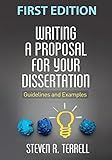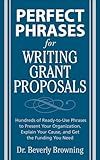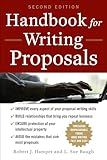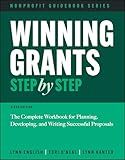Best Proposal Writing Tools to Buy in January 2026

Writing a Proposal for Your Dissertation: Guidelines and Examples



Perfect Phrases for Writing Grant Proposals (Perfect Phrases Series)



Million Dollar Consulting Proposals: How to Write a Proposal That's Accepted Every Time



Writing Winning Business Proposals, Third Edition



7 Steps to Better Writing: How to write better reports, proposals, email, blogs, and web content



Handbook For Writing Proposals, Second Edition



Winning Grants Step by Step: The Complete Workbook for Planning, Developing, and Writing Successful Proposals (The Jossey-Bass Nonprofit Guidebook Series)


Writing a proposal for research is a critical step in the research process. It outlines the objectives, methods, and scope of the proposed study, showcasing its significance and feasibility. Here are some essential elements to consider when drafting a research proposal:
- Introduction: Begin by introducing the research topic and its importance. Clearly state the research problem or question you aim to address. Demonstrate your understanding of the subject area and include any relevant background information.
- Objectives and Research Questions: Identify the specific goals and objectives of your research. Clearly articulate the research questions or hypotheses you plan to investigate. These objectives and questions should align with the problem statement mentioned in the introduction.
- Literature Review: Conduct a comprehensive literature review to demonstrate your knowledge of existing studies and theories related to your topic. Critically analyze and summarize relevant research, highlighting any gaps or limitations that your study aims to fill.
- Methodology: Describe your research design, explaining the methods and techniques you will employ to gather and analyze data. Clearly state whether your research will be qualitative, quantitative, or mixed methods. Specify the target population, sample size, data collection instruments, and analysis techniques you intend to use.
- Ethical Considerations: Assess potential ethical issues that may arise during the research, such as the protection of participants' privacy, informed consent, or any potential harm. Make sure to comply with ethical guidelines and obtain the necessary approvals, such as Institutional Review Board (IRB) permission if applicable.
- Timeline: Provide a realistic timeline for conducting the research. Break it down into specific milestones, such as literature review completion, data collection, analysis, and writing of the final report or thesis. Ensure that your proposed timeline matches the scope of your research.
- Resources: Outline the resources required for conducting the research, such as equipment, participant incentives, or access to specific databases or software. Consider any financial or logistical constraints and discuss how you plan to acquire the necessary resources.
- Limitations and Delimitations: Acknowledge the limitations or potential barriers to your study, such as time constraints, budgetary restrictions, or sample size limitations. Clearly explain the delimitations, or the boundaries of your study, which define what is included and excluded from your research.
- Significance and Expected Contributions: Highlight the potential impact and contribution of your research. Explain how it will advance knowledge in the field, address existing gaps, or provide practical applications. Emphasize the relevance and potential benefits that your research will bring.
- Conclusion: Summarize the key points of your proposal, reiterating its significance and feasibility. Demonstrate confidence in your ability to execute the research successfully. Additionally, include a bibliography or reference section that lists all the sources cited in the proposal.
Remember to adhere to any specific formatting guidelines provided by your institution or intended funding body while writing your research proposal.
What are some common pitfalls to avoid in research proposal writing?
- Lack of clarity in the research question: The research question should be clearly stated and specific, avoiding general or vague statements that can lead to confusion and ambiguity.
- Insufficient background knowledge: A research proposal should demonstrate a clear understanding of the existing literature on the topic. Failing to include a comprehensive literature review can weaken the proposal's argument and undermine its relevance.
- Lack of feasibility: It is essential to ensure that the proposed research is realistic in terms of time, resources, and scope. A proposal that is overly ambitious or lacks practicality may not be taken seriously by reviewers.
- Inadequate methodology: The proposal should outline a clear and appropriate research methodology, including the data collection methods, sample size, and statistical analysis techniques. A poorly articulated methodology can raise concerns about the research's validity and reliability.
- Weak justification for significance: A research proposal should explicitly outline the potential contribution and significance of the study. Failure to convincingly demonstrate the relevance and importance of the research can weaken the proposal's overall strength.
- Inadequate consideration of ethical issues: Ethical considerations, such as human subjects' protection, privacy, and confidentiality, should be addressed thoroughly in the research proposal. Ignoring or insufficiently addressing these ethical concerns can undermine the credibility of the research.
- Incomplete budget or financial plan: Proposals that lack a comprehensive budget for research expenses and a clear financial plan may be viewed as incomplete or poorly prepared. It is crucial to address financial considerations to ensure the feasibility and resource allocation of the research.
- Poor organization and structure: A well-structured research proposal should clearly outline the introduction, literature review, methodology, expected outcomes, and timeline. Poor organization and lack of coherence can make it difficult for reviewers to follow the proposal's logical flow.
- Inappropriate citation and referencing: A research proposal should accurately cite and reference all sources used in the literature review and any supporting evidence. Failing to do so can be seen as plagiarism or a lack of accountability for the proposed research.
- Inadequate proofreading and editing: Neglecting to thoroughly proofread and edit the research proposal can result in grammatical errors, typos, and unclear sentences. Such errors may lead reviewers to question the attention to detail and professionalism of the proposal writer.
How can you demonstrate the significance and originality of your proposed research?
To demonstrate the significance and originality of your proposed research, consider the following steps:
- Identify the research gap: Begin by clearly stating the existing problem or gap in knowledge that your research aims to address. This could be based on the limitations of previous studies, contradicting findings, new developments in the field, or emerging societal needs.
- Conduct a thorough literature review: Show your understanding of the existing literature by conducting a comprehensive review of relevant studies, theories, and methodologies. This will help you highlight the originality of your research by emphasizing how it builds upon and extends previous knowledge, or how it takes a fresh approach to the research question.
- Provide a clear research question or hypothesis: Clearly state your research question(s) or the hypothesis that your study aims to test. This helps to focus your research and demonstrate its importance within a specific context.
- Outline the potential contributions: Clearly articulate the potential contributions your research can make within the field. Highlight how your findings may fill the identified research gap, provide new insights, challenge or refine existing theories, or offer practical applications that can advance knowledge or address real-world problems.
- Explain the methodology and innovation: Describe your proposed research methodology, including the data collection and analysis techniques. Demonstrate how your methodology is unique, innovative, or provides an improved approach compared to previous studies. This can involve the use of new technologies, novel conceptual frameworks, or interdisciplinary approaches.
- Discuss the broader implications: Consider the potential broader implications of your research beyond the immediate field of study. Discuss how your findings may have practical applications, inform policy-making, contribute to social change, or impact related disciplines.
- Emphasize feasibility and significance: Outline the feasibility of your research by discussing the available resources, required expertise, and potential challenges. Additionally, clearly state why your research is significant and deserving of funding or attention. Consider the potential benefits to society, the scientific community, or any other relevant stakeholders.
Remember, effective communication and presentation of your research proposal are essential when demonstrating its significance and originality. Tailor your arguments to your target audience, be concise yet thorough in your explanations, and provide clear justifications and evidence to support your claims.
How can you demonstrate your qualifications and expertise in the proposal?
There are several effective ways to demonstrate qualifications and expertise in a proposal:
- Provide a clear and concise summary: Start by highlighting your qualifications and expertise in the executive summary or introduction of the proposal. Clearly state your skills and experience that make you the right candidate or company for the project.
- Showcase relevant experience: Include a section that outlines your past experience in similar projects or industries. Highlight successful outcomes or achievements that demonstrate your expertise and ability to deliver results.
- Provide client testimonials or case studies: Include testimonials or case studies from previous satisfied clients or customers. These testimonials can support your claims of expertise and qualifications by showcasing real-life examples of how your services or products have benefited others.
- Highlight relevant certifications or credentials: If you or your team members hold any certifications or special qualifications related to the project, make sure to highlight them. Certifications demonstrate your commitment to continuing education and show that you have acquired the necessary skills and knowledge to excel in the field.
- Demonstrate knowledge of the industry or market: Show that you understand the industry or market in which the proposal is targeted. Include relevant statistics, trends, or insights that highlight your deep knowledge of the subject matter, and explain how this knowledge positions you as a qualified expert in the field.
- Provide a detailed project plan: Provide a comprehensive and well-thought-out project plan that demonstrates your expertise in handling the specific requirements of the proposal. Detail each step, including timelines, resources, and potential challenges, to demonstrate your ability to execute the project successfully.
- Offer relevant references: Include references from previous clients or collaborators who can vouch for your qualifications and expertise. This adds credibility to your proposal by showing that others have trusted and valued your services in the past.
Remember to tailor your qualifications and expertise demonstration to the specific needs and requirements outlined in the proposal. This customization will make your proposal more impactful and increase your chances of success.
What is the importance of a timeline and milestones in a research proposal?
A timeline and milestones are essential components of a research proposal as they provide a structured plan and outline key stages of the research project. Here are some reasons for their importance:
- Demonstrating planning: A timeline and milestones demonstrate that the researcher has carefully considered the various tasks and activities required for the research project. It shows that the researcher has thought about the necessary steps to achieve the research objectives.
- Project management: A timeline helps in managing the project effectively by breaking down the tasks into smaller, manageable units. It allows the researcher to allocate resources, including time and funding, appropriately throughout the research project.
- Accountability: A timeline and milestones hold the researcher accountable for completing specific tasks within a predetermined timeframe. This helps in maintaining focus and avoiding procrastination, ensuring progress is made towards the research goals.
- Tracking progress: A timeline provides a visual representation of the project's progress, allowing the researcher, supervisors, and stakeholders to track the completion of specific milestones and ensure the research is on schedule.
- Identifying dependencies and potential bottlenecks: Establishing a timeline and milestones helps identify dependencies and potential bottlenecks in the research project. This ensures that tasks are scheduled in a logical sequence and that any potential issues or challenges can be addressed in advance.
- Facilitating collaboration and coordination: When multiple researchers or teams are involved in a research project, a timeline and milestones aid in coordinating efforts and ensuring that everyone is aware of their responsibilities and timelines. It promotes effective communication and collaboration among team members.
- Grant funding applications: A timeline and milestones are often required elements in grant funding applications. Funding agencies want to see a clear plan and timeline for the proposed research to ensure that resources are utilized effectively and the project can be completed within the allocated timeframe.
Overall, a timeline and milestones in a research proposal provide structure, organization, and accountability to the research project. They help in planning, managing, and tracking progress, while also ensuring that the research aims and objectives are achieved effectively and efficiently.
What are the key components of a research proposal?
The key components of a research proposal generally include:
- Title: A concise and descriptive title that reflects the focus and scope of the research.
- Abstract: A brief summary of the proposed research, highlighting the research problem, objectives, methods, and significance.
- Introduction: An introduction to the research topic, including a statement of the problem, background information, and the rationale for conducting the research.
- Research questions or objectives: Clearly stated research questions or objectives that outline what the researcher wants to achieve or explore.
- Literature review: A comprehensive review of existing literature and research relevant to the topic, demonstrating the researcher's knowledge of previous work in the field.
- Methodology: A description of the research design, data collection methods, and analysis procedures. This section should outline how the researcher plans to address the research questions or objectives.
- Timetable: A detailed timetable or timeline that outlines the intended timeframe for each phase of the research project.
- Ethical considerations: A discussion of any potential ethical issues that may arise during the research process and how they will be addressed.
- Budget: A breakdown of the anticipated costs associated with the research, including any funding or resources required.
- Expected outcomes: An explanation of the expected outcomes of the research, including the potential contributions to the field and any practical applications.
- References: A list of the relevant sources cited throughout the proposal.
- Appendices: Any additional supporting documents, such as questionnaires, surveys, or interview transcripts.
It is important to note that the specific components and their order may vary depending on the requirements of the funding organization or academic institution.
What should be included in the introductory section of a research proposal?
The introductory section of a research proposal should typically include the following components:
- Title: The title should be concise and descriptive, providing a clear indication of the research topic.
- Background and Context: Provide an overview of the research problem or topic, presenting relevant background information, previous research, and the existing gaps or limitations in the field. This section should establish the importance and relevance of the proposed research.
- Research Problem or Objective: Clearly articulate the specific research problem or objective that the study aims to address. State the research question(s) or hypothesis(es) that will guide the investigation.
- Research Purpose and Scope: Explain the purpose of the study and the main objectives or goals. Describe the intended scope of the research, including the target population, time frame, and geographical location, if applicable.
- Significance and Justification: Emphasize the significance and potential impact of the research. Discuss how the study can contribute to existing knowledge or theory, fill gaps in the literature, or have practical implications. Provide a rationale for why the research is important and why it should be conducted.
- Research Design and Methodology: Briefly outline the proposed research design and methodology, including the research approach (e.g., qualitative, quantitative, mixed methods), data collection techniques, and data analysis methods. This section should give an overview of the planned research procedures.
- Limitations and Delimitations: Address any potential limitations or constraints that may affect the study's validity or generalizability. This could include limitations related to resources, time, access to data, or a specific population. Also, clarify the delimitations, which define the boundaries or scope of the research.
- Expected Outcomes and Contributions: Provide an overview of the expected outcomes or findings of the proposed research. Discuss the potential contributions to the field, whether they are theoretical, practical, or methodological.
- Overview of Dissertation/Thesis Structure: Give a brief outline of the structure and organization of the dissertation or thesis. Provide an overview of the chapters or sections that will be included and their sequence.
Remember that the content and structure of the introductory section may vary depending on the specific requirements of your research proposal and the guidelines provided by your academic institution.
